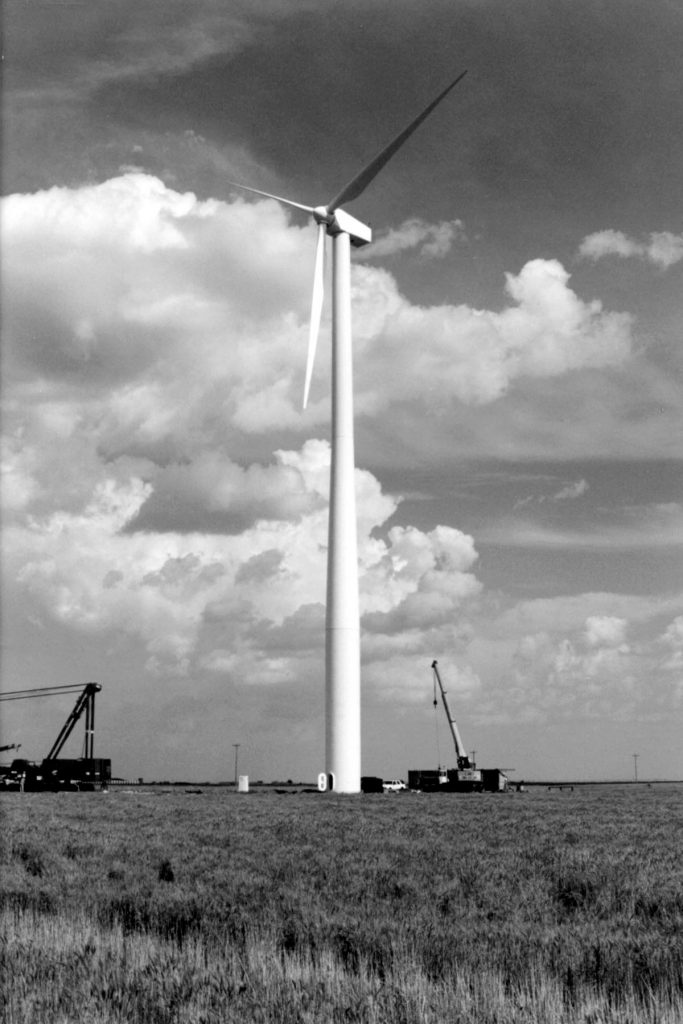
ALBUQUERQUE, N.M. — To stimulate development of wind power resources essentially untapped in New Mexico, the U.S. Department of Energy’s (DOE) Sandia National Laboratories has contracted to purchase “green” electricity generated by an already-in-place wind turbine near Clovis, N.M.
The ecologically desirable power source, purchased through the DOE Albuquerque Operations Office’s (DOE/AL) Utilities and Energy Management Team (UEMT) is expected to provide electricity for approximately six percent of the DOE’s Waste Isolation Pilot Plant (WIPP) total electric services requirement.
Sandia scientists hope this purchase, along with others over a 10-year period, will stimulate the growth of a New Mexico wind power industry.
For starters, Sandia’s purchase triggers the installation of an additional wind turbine and is intended to stimulate further economic development in the state. Eastern New Mexico electricity provider Xcel Energy’s Southwestern Public Service Company, through its Windsource program will deliver energy produced by both turbines.
In addition, “We intend to purchase one megawatt of wind-generated power in 2001, ramping up to 10 megawatts of renewable power within 10 years,” says Sandia executive vice-president Joan Woodard. Because wind power sources will be competitively selected, “Sandia’s purchase of this wind-generated power should promote wind development in New Mexico, provide economic and environmental benefits, and help meet DOE’s goals as well as our nation’s. We hope to encourage other government and private sector purchasers to join us in expanding the role of renewable energy.”
Michael Loera, DOE/AL’s UEMT contracting officer says, “It is fantastic that we collectively brought this renewable resource acquisition to fruition. Not only are we furthering the State of New Mexico’s economic development initiatives but we have set forth a ‘benchmark’ whereby we can continue to measure, apply and improve our contracting techniques to foster renewable resource acquisitions in New Mexico, Nevada and Texas.”
New Mexico is the 12th windiest state in the nation and, according to a DOE study, is capable of producing more than 10 times the current state electricity consumption.
“The wind blows everywhere sometimes,” says Sandia senior scientist Al Zelicoff. “With multiple wind turbines in enough places, electricity can be sent from one location to another, including Albuquerque and buyers out-of-state.”
Ecologically, he says, “The need for cleaner technologies is unquestioned. Hundreds of tons of carbon dioxide are produced yearly for every house using conventionally generated electricity. In 20 years, there will be twice as much material from human activity going into the atmosphere — from the generation of electricity alone — unless we seek cleaner methods.”
When developing countries with huge populations increase their use of electricity, emissions problems are expected to increase unless clean generating methods are available.
The Sandia action responds to a DOE mandate to use renewable resources to generate 7.5 percent of the electricity used at DOE sites by 2010. The funds needed to purchase clean electricity from the slightly more expensive green power source is being paid for by Sandia from cost savings derived through the Labs’ energy conservation efforts, thus requiring no additional taxpayer dollars. Sandia purchases should significantly exceed the DOE mandate. In fiscal year 2000, Sandia provided DOE with $45,000 in funds.
Currently, electricity can be produced from fossil fuels for about 3 cents/kwh; wind, 6 cents. But the researchers expect the cost of wind power to drop as technology improves. “We expect the market for wind power to be fully competitive in many regions of the United States before 2010,” says Sandia researcher Henry Dodd.
Wind power already in place
California already generates more than a gigrawatt (a billion watts) of power from wind power. Texas expects to generate two gigawatts of renewable power, mostly wind, by 2008.
Recent improvements in wind generators involve using much bigger machines that reach higher into the atmosphere to access stronger winds. “You could park a 747 within the diameter of these newer wind turbines,” says Dodd. Also, better manufacturing processes are creating stronger blades.
“In Europe, wind generators are installed in relatively small groups on plots of public land and considered things of beauty. People love them,” says Zelicoff.